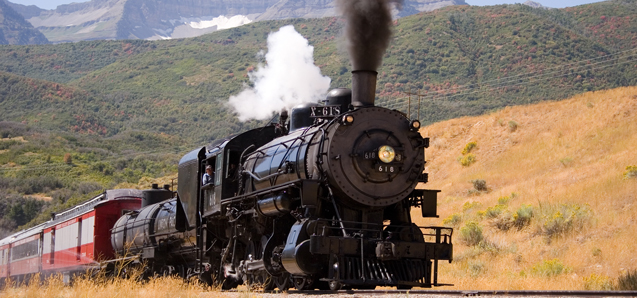
Union Pacific 618 (OSL 1068)
Built for: Oregon Short Line Railroad Company No. 1068
Work History: In service on Oregon Short Line 1907 – 1915
To Union Pacific No. 618 c. 1915
In service on Union Pacific 1915 – 1958
Retired, donated for display at Utah State Fair, June 1958
To Promontory Chapter, NRHS 1969
Leased to Wasatch Mountain Railway 1970 – 1990
(restored for service 1970 – 1976, 1986 – 1990)
To Heber Valley Historic Railroad Authority, 1992
restored to service in 1995
Temporary renumbering to OSL 1068, 2007
Wheel Arrangement: 2-8-0
Builder: Baldwin Locomotive Works (Burnham, Williams & Co.)
Date Constructed: July, 1907
Construction Number: 31250
Class: C-57
Boiler Pressure (working): 200 PSI
Drive Wheel Diameter: 57″
Weight: 212,800 lbs
Weight on Drivers: 191,000 lbs
Tractive Effort: 43,350 lbs
Cylinders: 22″ x 30″
Valves: Piston
Valve Gear: Stevenson Link Motion
Fuel: Coal
Tender: Vanderbilt (built by General Steel Castings) 9000 gallons/15 tons coal
Current Status: Waiting for boiler inspection
Steam Locomotive No. 618 is one of the stars of the Heber Valley Railroad locomotive fleet. This historic engine, which turned 100 years old in 2007, has been pulling tourists through the Wasatch Mountains since 1971.
No. 618 is a 2-8-0 or Consolidation-type locomotive, meaning it has two unpowered pony truck wheels, eight powered drive wheels, and no wheels under the cab. At one time there were over 1000 locomotives like it working for the Union Pacific Railroad, which took delivery of its first 2-8-0 in 1868. They were first used on the steep grades in Wyoming Territory in main line freight service, though they proved very adept at just about every task, be it yard switching to fright service to passenger duties.
This type of engine was such a standard type of fright locomotive that nearly all major railroads owned dozens of them, and practically all smaller railroads had at least one on the roster. The 2-8-0 is a very versatile design in that a locomotive the size of the No. 618 could pull, by itself, a freight train of fifty or sixty freight cars over level track, or it could be double-headed with another locomotive for heavier train or steep grades. Although not specifically designed as a passenger engine, many smaller rail lines used them for that purpose.
No. 618 started life in the erecting halls of the Baldwin Locomotive Works at Eddystone, Pennsylvania in July 1907. The 2-8-0 was part of a three locomotive order from the Oregon Short Line Railroad (a subsidiary of the Union Pacific) built that month by Baldwin and numbered 1066-1068. The OSL, which had roots back to the narrow gauge Utah Northern, ran from northern Utah and into Idaho, Wyoming and Montana. It survived the bankruptcy of the Union Pacific in the late 1890s because of its status as a separate company.
Mechanically speaking, the No. 618 is equipped with 22″ X 30″ piston valves, Stevenson valve gear, 57-inch drive wheels, and a superheated boiler. Its boiler has 286 fifteen-foot tubes, and a working pressure of 200 PSI.
Working for the OSL the No. 1068 was employed mainly in freight service, most likely in northern Utah and Southern Idaho on the main line to Pocatello. Its early years are clouded in mystery, but we do know that when the Oregon Short Line locomotives were numbered into the UP system around 1915, the No. 1068 became Union Pacific No. 618 (it was still designated an Oregon Short Line locomotive, evidenced by the “O.S.L.” initials on the sides of the cab and the rear of the tender.) It was classified as a “C-57” – “C” for Consolidation and “57” designating its 57-inch drive wheels.
No. 618’s last major shopping while on the Union Pacific was at the railroad’s, Pocatello, Idaho shops in 1941. At that time it received all new tubes and flues, wheel and running gear work, and a complete renewal of worn parts. Around that time its square tender was replaced with a Vanderbilt model (the same tender it has today) that holds 9,000 gallons of water and 15 tons of coal.
After this No. 618 went to work around the Ogden, Utah area; during this time its home was a stall in the UP’s Ogden roundhouse. During World War II it was often used on the track running between the Ogden yard and the Defense Depot Ogden (an Army storage facility north of the city) hauling equipment and supplies desperately needed for the war effort.
After 1945 and the end of the war, No. 618 was sent to northern Utah and assigned to the Union Pacific’s Cache Valley Branch between Mendon and Logan, and also saw service on the Malad line. By 1955 diesels had rendered it obsolete, and it served its last years working at Ironton, moving bottle cars of molten iron to the Geneva Steel plant.
In 1958 the No. 618 was donated to the State of Utah, and placed on display at the Utah State Fairgrounds in Salt Lake City. It sat there until 1970, when the land it occupied was needed for expansion. But how to remove it from the fairgrounds? Legend has it that one idea was to dig a hole and bury it, and that this came close to happening! Fortunately, a local railroad club – the Promontory Chapter of the National Railway Historical Society – intervened and saved the engine. Their members convinced the State of Utah to donate the engine to their group, for use on the Heber Creeper operation then being started at Heber City. It was moved to Provo, then steamed up and run under its own power through Provo Canyon to Heber City in December 1970.
From that time on, No. 618 was a regular attraction at Heber City. It pulled the Heber Creeper from 1971 until 1976, then again from 1986 until 1990. During that time the Promontory Chapter owned the engine and leased it to the Wasatch Mountain Railway. In 1992, the locomotive was donated to the State of Utah for use by the Heber Valley Historic Railroad, and in June 1992 it was towed from the old property to the new Heber Valley railroad yard.
For several years the No. 618 sat idle. After two decades of service, the 2-8-0 needed a complete overhaul before it could run again. It sat on static display near the Heber station until the end of 1993, when the Heber Valley’s new state-of-the-art restoration shop was completed. Between 1994 and 1995 it was completely overhauled inside the new building, and then debuted with fanfare on May 13, 1995, pulling the first train of the ’95 season to Deer Creek Dam and back.
Over the years the engine has starred in movies and television programs, pulled the Olympic flame, and has been the subject of numerous magazine and newspaper articles. In celebration of its 100th birthday in 2007, it was temporarily relettered as Oregon Short Line No. 1068, the historic locomotive’s first number.
With your help we expect the required boiler inspection and other restoration to be complete in the near future, and then look forward to it operating for many more years to come.
